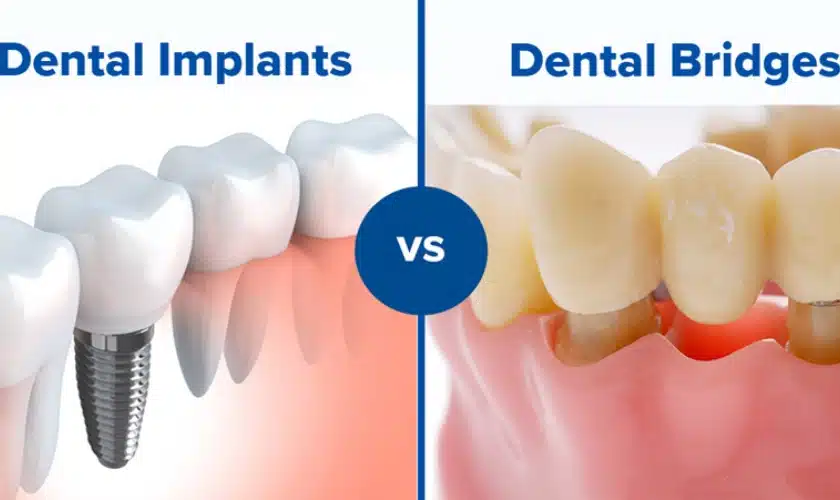The Of Dental Sense
The Of Dental Sense
Blog Article
Fascination About Dental Sense
Table of ContentsTop Guidelines Of Dental SenseOur Dental Sense StatementsUnknown Facts About Dental SenseHow Dental Sense can Save You Time, Stress, and Money.
are clinical tools surgically dental implanted right into the jaw to recover an individual's capacity to chew or their look. They offer assistance for man-made (phony) teeth, such as crowns, bridges, or dentures. When a tooth is shed because of injury or illness, a person can experience complications such as rapid bone loss, faulty speech, or adjustments to eating patterns that cause discomfort.Oral dental implant systems include an oral implant body and dental implant joint and might additionally include a joint fixation screw. Dental implant vs bridge. The oral implant body is operatively put in the jawbone in location of the tooth's root. The oral implant abutment is typically connected to the dental implant body by the abutment fixation screw and prolongs through periodontals right into the mouth to support the attached artificial teeth
(https://justpaste.it/hj6ob)Structure of The Oral Implant System picking dental implants, speak with your dental service provider regarding the potential benefits and risks, and whether you are a candidate for the treatment. Points to consider: Your general health is an essential element in figuring out whether you are an excellent candidate for oral implants, how long it will take to recover, and the length of time the implant may remain in location.
Smoking cigarettes might influence the recovery process and decrease the long-term success of the dental implant. The healing procedure for the dental implant body might take several months or longer, during which time you typically have a short-term abutment in area of the tooth. the oral implant treatment: Meticulously comply with the dental health directions provided to you by your oral copyright.
Little Known Facts About Dental Sense.
Implant failing can cause the requirement for another operation to take care of or replace the dental implant system. Recovers the ability to eat Brings back aesthetic look Assists keep the jawbone from shrinking as a result of bone loss Preserves the health of the surrounding bone and gum tissues Helps maintain nearby (neighboring) teeth steady Improves lifestyle Damages to surrounding all-natural teeth throughout implant placement Injury to the surrounding cells during surgical treatment, such as sinus opening Injury during surgery (as an example, crack of bordering jawbone) Inadequate feature, such as really feeling like the teeth do not attack together typically An experience that the tooth is loose or twisting in position resulting from a joint screw loosening up Implant body failing (looseness of the dental implant body) as a result of systemic infection, which may be most likely in patients with unchecked diabetes mellitus as a result of neighborhood infection in bone and gum tissues sustaining the dental implant body due to delayed healing, which might be most likely in people who smoke Trouble cleaning the periodontals around the dental implant, leading to bad dental hygiene Unattended gum disease Post-surgical feeling numb as a result of nerve impingement or damage Always notify health and wellness care service providers and imaging specialists that you have dental implants prior to any kind of magnetic vibration imaging (MRI) or x-ray treatments.
FDA is not knowledgeable about any damaging events reported for MRI or x-ray treatments with oral implants. Oral implants systems are commonly made of products that comply with international agreement standards of the International Company for Standardization (ISO) or ASTM International. These criteria have details of what makes a risk-free material.

An oral implant is a structure that replaces a missing tooth. With screw-like gadgets, the specialist inserts an implant right into the jawbone, and it acts as a support for a man-made tooth, called a crown.
Dental Sense Things To Know Before You Get This
Some individuals are not eligible for oral implant surgical treatment. It is for dental cosmetic surgeons to operate on individuals with: acute illnessuncontrollable metabolic diseasebone or soft tissue disease or infectionIf these issues are settled, an individual can have the surgery. In, oral surgeons avoid operating people with: If individuals with any of the above undergo dental implant surgical procedure, there is a greater danger of the dental implant stopping working.

Oral dental implant surgical procedure is a customized procedure. Offer you time to heal. Attach the blog post and final crown, bridge or denture.
Next, your specialist will thoroughly position the oral implant right into your jaw. Ultimately, your specialist will certainly reposition your gums and close the laceration with stitches. If your dental implant is near the front of your mouth, your dental practitioner will certainly make a temporary tooth for you to put on till you heal. By doing this, you won't have a gap in your smile while you recoup.
Get This Report about Dental Sense
Your service provider can inform you what to anticipate in your situation. Throughout the recovery phase, your jawbone must fuse to the oral implant. This procedure, called osseointegration, is important for stability and long-term success. This process can take anywhere from three to nine months. In some cases, it may take much longer.
When your implant heals, your dental professional can affix the joint (small adapter post) and your last remediation (crown, bridge or denture). This typically takes about one hour to finish and may require a 2nd minor surgical procedure. You should not feel any type of discomfort during your oral implant procedure since your supplier will certainly utilize drug to numb your periodontals.
Report this page